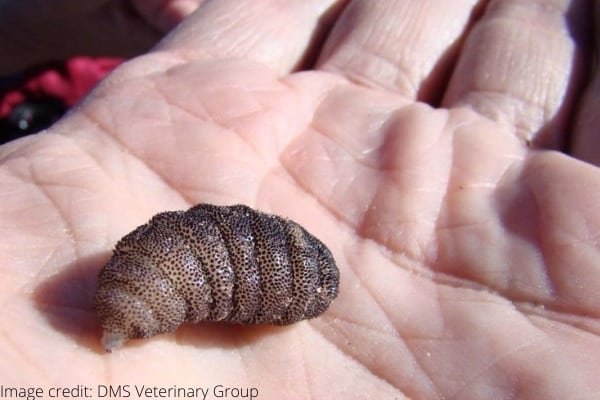
So, let’s break this down. Wolf worm larvae, which are the offspring of the **Cuterebra** fly, can infest rodents, particularly rabbits and squirrels. Once they make themselves comfortable, they burrow into the host’s skin, causing a whole lot of discomfort and health concerns. If you’re a pet owner or someone living near wild rodent populations, grasping the nature of these pests and learning how to control them is crucial.
In this article, we’ll cover everything you need to know about wolf worm larvae, including how they affect rodent colonies and effective control tips to keep these pesky invaders at bay.
What Are Wolf Worm Larvae?
Wolf worm larvae are the larval stage of the **Cuterebra** fly, a type of botfly. These larvae mostly target small mammals like **mice**, **rats**, rabbits, and other rodents. Imagine them as mean little passengers hitching a ride on their unsuspecting hosts. The life cycle begins when a female **Cuterebra** lays her eggs near rodent burrows or nests.
When the eggs hatch, the tiny larvae crawl onto a rodent and enter its body through natural openings or wounds. Once inside, they mature over a few weeks, growing and feeding on the host’s tissue. It’s pretty nasty stuff! The discomfort can lead to serious health problems for the rodent, including **inflammation**, **infection**, and, in some cases, even death.
You might wonder why this matters to us. Well, these infestations can lead to larger issues, especially if infected rodents come into contact with pets or humans. So, it’s essential to keep an eye on rodent populations in your area.
Identifying Infestations
Knowing how to spot wolf worm larvae infestations is the first step in addressing the problem. You might be wondering what signs to look for in affected rodent colonies. Here are a few things to watch out for:
- Swelling or lumps: If you see unusual bumps on rodents, they could be harboring larvae.
- Behavior changes: Infected rodents may appear lethargic, uncomfortable, or exhibit strange behaviors, like excessive grooming.
- Presence of the Cuterebra fly: If you see these flies buzzing around rodent habitats, they’re likely laying eggs nearby.
If you notice any of these signs, it’s a call to action! Keeping an eye on your surroundings will help catch infestations before they spiral out of control.
Preventing Wolf Worm Infestations
Prevention is always better than cure, right? So, how can you stop wolf worm larvae from taking root in rodent colonies? Here are some handy tips to consider:
- Maintain cleanliness: Keep areas around your home free from food sources that attract rodents.
- Seal entry points: Inspect your house for cracks or holes that rodents could use to enter. Seal these with appropriate materials.
- Control rodent populations: Implement safe trapping or baiting strategies to keep the rodent population in check.
By using these methods, you create an environment that’s less inviting for both rodents and the pesky **Cuterebra** flies.
Effective Control Methods
If you discover an infestation, it’s important to know how to handle it effectively. There are a few approaches you can take to control wolf worm larvae:
1. **Professional Pest Control**
If you’re dealing with a larger-scale infestation, calling in the pros can be a smart move. Pest control experts can assess the situation and implement effective strategies to eliminate larvae and prevent future occurrences.
2. **Humane Trapping**
For smaller infestations, consider humane traps to capture live rodents. After capturing them, it’s best to relocate them far from your home, as this helps control their population without unnecessary harm.
3. **Cleaning and Disinfection**
After dealing with an infestation, don’t forget to clean the area thoroughly. Use disinfectants to reduce the chance of attracting more rodents and pests to the same spot.
These methods not only help eliminate the larvae but also address the root causes of the infestation.
Health Implications for Rodents
Infestations of wolf worm larvae can lead to some serious health issues for rodents. This is something worth discussing. Here’s what happens when they get infested:
– **Skin infections:** As the larvae burrow into the skin, they can cause open wounds, which can easily get infected. It’s a painful situation for the host rodent.
– **Systemic infections:** If left untreated, the infections can spread, leading to more severe health problems that are sometimes fatal.
– **Behavioral changes:** Infected rodents may become disoriented or overly aggressive, which can disrupt their social structure within colonies.
By understanding the health implications, you can appreciate why controlling these larvae is so important—not just for the rodents themselves but also for the ecosystem as a whole.
Dealing with wolf worm larvae in rodent colonies may seem like a daunting task, but with the right tools and understanding, you can effectively manage the situation. Remember, it starts with prevention—keeping your space clean and monitoring rodent populations. If an infestation occurs, don’t hesitate to use humane traps or reach out to professionals.
By implementing these control tips, you can help safeguard both rodent and human health. It’s a win-win for everyone involved. Stay vigilant and proactive, and you can keep those pesky worms at bay!
